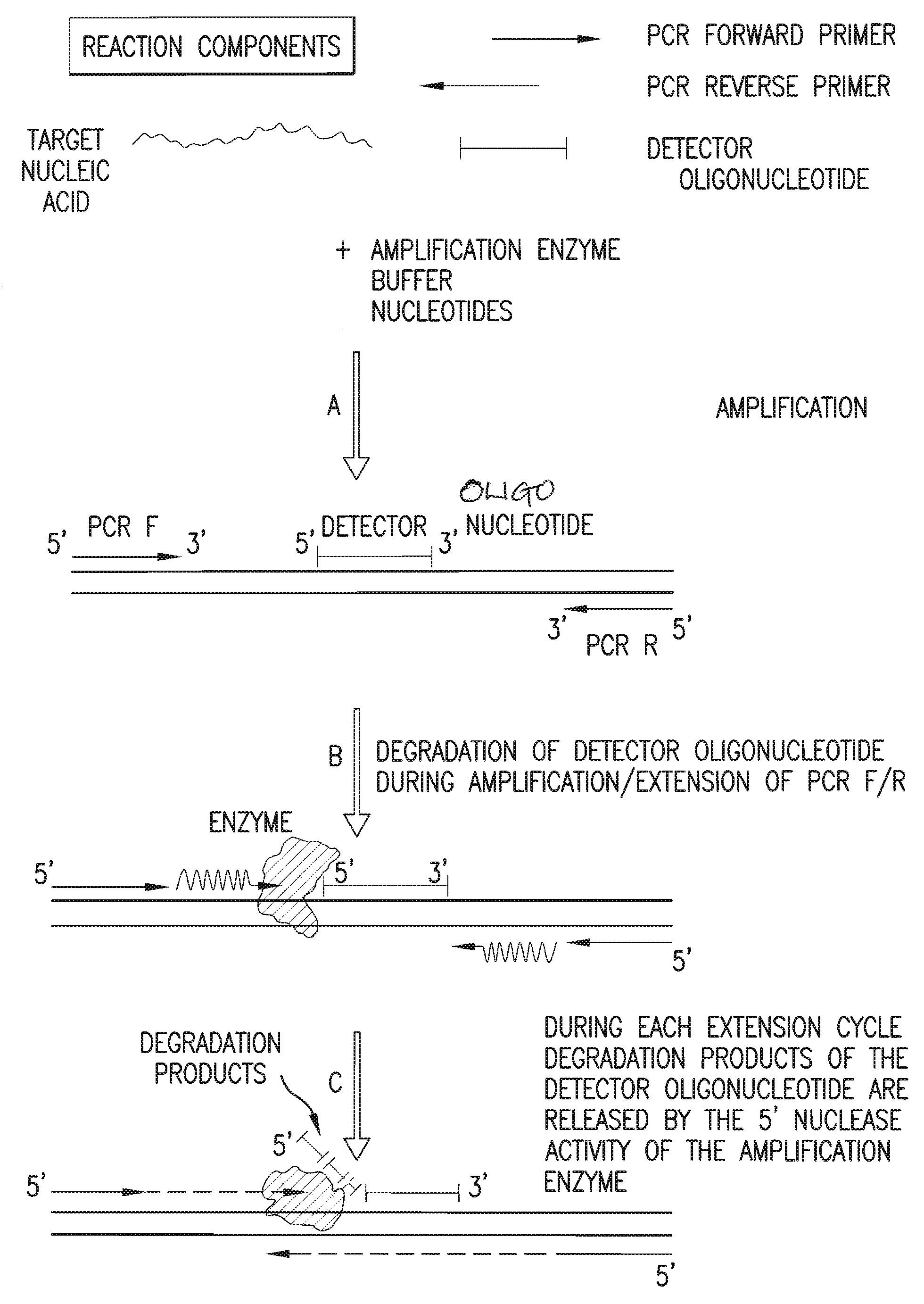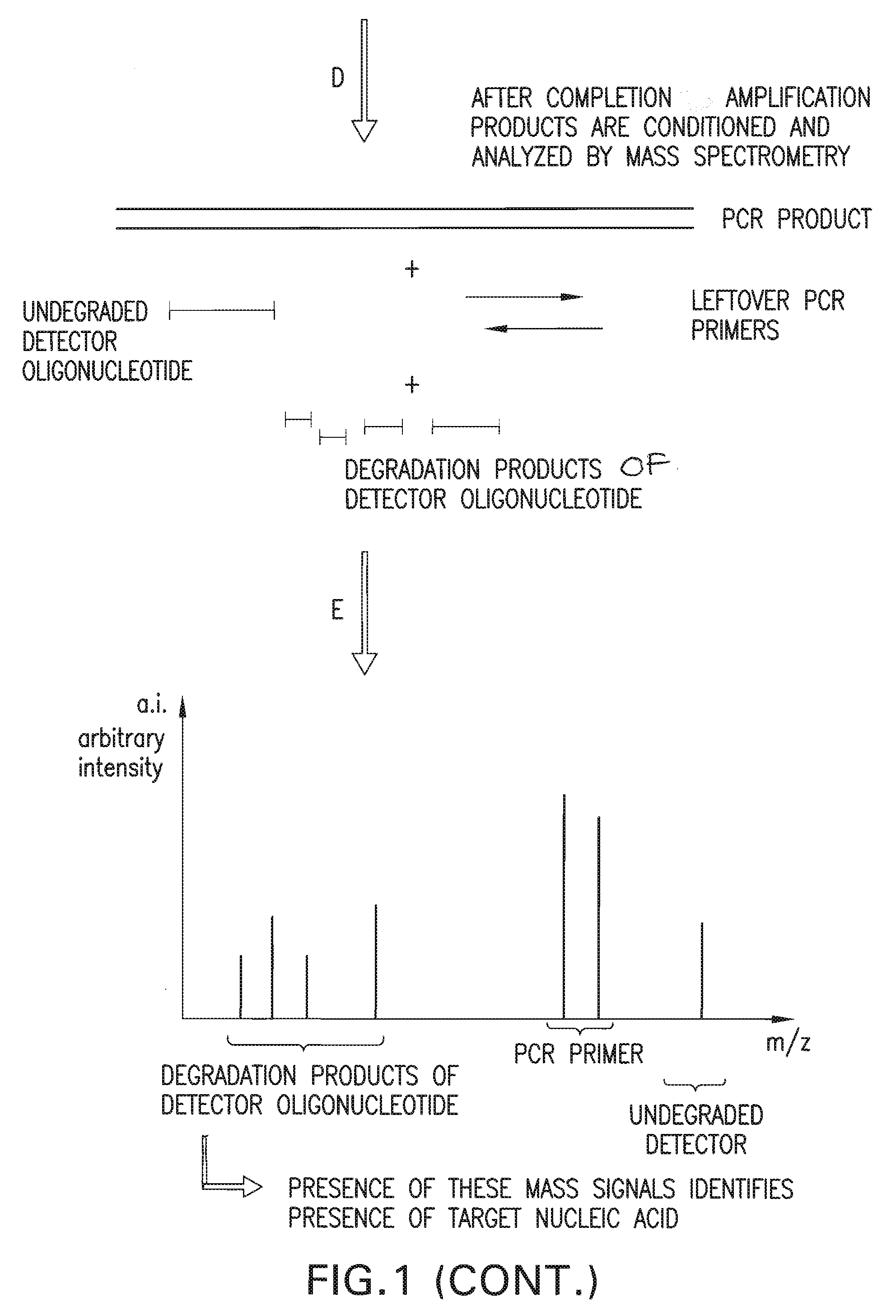Detection and quantification of biomolecules using mass spectrometry
a mass spectrometry and biomolecule technology, applied in the field of detection and quantification of biomolecules using mass spectrometry, can solve the problems of single detection moiety overlapping and obscured signals, and achieve the effect of avoiding post-pcr enzymatic processes
- Summary
- Abstract
- Description
- Claims
- Application Information
AI Technical Summary
Benefits of technology
Problems solved by technology
Method used
Image
Examples
example 1
Detection of Exon 10 of the RhD gene
[0142]A detection assay was performed to detect the exon10 region of the Rhesus D gene. Design of PCR primers and detector oligonucleotide was performed according to the detailed description section. In this particular assay, the detector oligonucleotide carries a non-complementary 5′ overhang consisting of 6 Adenines. Since the target sequence (Exon10 of RhD) was present in the sample, the PCR primers and the detector oligonucleotide hybridized to the target. During amplification, the detector oligonucleotide was degraded by the 5′ nuclease activity of the DNA polymerase extending from the upstream PCR primer. During degradation, mass-distinguishable products (MDP's) including the 5′ polyA tag were released and identified unambiguously by mass spectrometric analysis (See FIG. 8). Detection of these mass signals confirmed the presence of the target nucleic acid.
Primer and Detector Oligonucleotide Sequences:
[0143]The following primers were used for...
example 2
Detection of Exon 5 of the RhD Gene
[0152]A detection assay was performed to detect the exon5 region of the Rhesus D gene. Design of PCR primers and detector oligonucleotide was performed according to the detailed description section. In this particular assay, the detector oligonucleotide carries a non-complementary 5′ overhang consisting of 8 Adenines. Since the target sequence (Exon5 of RhD) was present in the sample, the PCR primers and the detector oligonucleotide hybridized to the target. During amplification, the detector oligonucleotide was degraded by the 5′ nuclease activity of the DNA polymerase extending from the upstream PCR primer. During degradation, mass-distinguishable products (MDP's) including the 5′ polyA tag were released and identified unambiguously by mass spectrometric analysis (See FIG. 9). Detection of these mass signals confirmed the presence of the target nucleic acid.
Primer and Detector Oligonucleotide Sequences
[0153]The following primers were used for amp...
example 3
10-Plex Set of Y-Chromosome Markers for Gender Determination Using Modified Detector Oligionucleotides that Contain LNAs and 3′ Extension Blockers
[0162]A detection assay was performed to detect ten regions specific for the Y-chromosome. PCR primers and detector oligonucleotides were designed to meet the criteria described in the present invention using methods well known in the art. For example, the detector oligonucleotides were designed with a melting temperature approximately 10 degrees Celsius higher than the PCR primers. Further, a polyA / G tail was added to the 5′-end of the detector oligonucleotide with the length and sequence variable in order to space and resolve cleavage products within a 2000-6000 Da window on the MALDI-TOF MS.
[0163]In this particular multiplexed assay, the detector oligonucleotides carry a non-complementary 5′-overhang consisting of multiple Adenines and / or Guanines. In samples where the Y-chromosome is present (such as male samples), the PCR primers and ...
PUM
 Login to View More
Login to View More Abstract
Description
Claims
Application Information
 Login to View More
Login to View More - R&D
- Intellectual Property
- Life Sciences
- Materials
- Tech Scout
- Unparalleled Data Quality
- Higher Quality Content
- 60% Fewer Hallucinations
Browse by: Latest US Patents, China's latest patents, Technical Efficacy Thesaurus, Application Domain, Technology Topic, Popular Technical Reports.
© 2025 PatSnap. All rights reserved.Legal|Privacy policy|Modern Slavery Act Transparency Statement|Sitemap|About US| Contact US: help@patsnap.com



